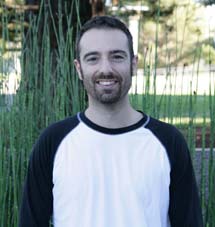
Handy Links
SLAC News Center
SLAC Today
- Subscribe
- Archives: Feb 2006-May 20, 2011
- Archives: May 23, 2011 and later
- Submit Feedback or Story Ideas
- About SLAC Today
SLAC News
Lab News
- Interactions
- Lightsources.org
- ILC NewsLine
- Int'l Science Grid This Week
- Fermilab Today
- Berkeley Lab News
- @brookhaven TODAY
- DOE Pulse
- CERN Courier
- DESY inForm
- US / LHC
SLAC Links
- Emergency
- Safety
- Policy Repository
- Site Entry Form

- Site Maps
- M & O Review
- Computing Status & Calendar
- SLAC Colloquium
- SLACspeak
- SLACspace
- SLAC Logo
- Café Menu
- Flea Market
- Web E-mail
- Marguerite Shuttle
- Discount Commuter Passes
-
Award Reporting Form
- SPIRES
- SciDoc
- Activity Groups
- Library
Stanford
Around the Bay
David Paneque in Free Fall
 On his days off, David Paneque enjoys a beautiful view, a cool breeze through his hair, and a free fall from 14,000 feet. Paneque is
earning his group certification in skydiving. He has jumped more than 30 times this year.
On his days off, David Paneque enjoys a beautiful view, a cool breeze through his hair, and a free fall from 14,000 feet. Paneque is
earning his group certification in skydiving. He has jumped more than 30 times this year.
Spinning, flipping and tracking as he falls, Paneque is improving his technique and learning to control his movements. "It's like driving," he says. "You get used to moving with the air. The goal is to be able move precisely without thinking." He is working toward his certification to jump with other skydivers, who together make formations and perform stunts. "In the beginning it's challenging," he continues. "When you approach the door of the plane, some part of you is saying 'Why the hell are you doing this? Get away from that door right now!' It's challenging learning to control your fears."
Paneque enrolled in a skydiving class in 2007, and began jumping regularly in 2008. He makes his jumps over some wide open spaces near Byron, a little more than an hour east of Menlo Park. But he made his first tandem jump over Girona, Spain, in 2001, much closer to his hometown of Barcelona. Since leaving home, Paneque has also lived in Munich, Germany, where he worked as a PhD student then as a postdoctoral researcher with the Major Atmospheric Gamma-ray Imaging Cherenkov Telescope. He joined SLAC in 2006 as a research associate working on the Gamma Ray Large Area Space Telescope. After living in so many different places, Paneque is making a home for himself at SLAC. "Do the work you want to do, and be surrounded by people you feel comfortable with," he says. "The rest is just details."
Paneque keeps himself busy working on both the software engineering and scientific sides of GLAST. He spends a great deal of time writing and analyzing code that monitors the status of the Large Area Telescope detector, the instrument that performs gamma-ray astronomy. He talks enthusiastically about the data that GLAST is acquiring, in particular that data related to Active Galactic Nuclei, or AGN, which are compact regions at the centre of galaxies that can sometimes outshine the host galaxy. "The ultimate energy source of those objects is commonly believed to be from the release of gravitational potential energy of matter from an accretion disk surrounding a super-massive black hole, 10 million to 100 billion times the mass of the sun," says Paneque. "GLAST/LAT will provide very sexy data that will surely be of key importance to understand how those mysterious objects work."
Paneque also divides his free time between playing soccer and basketball, salsa dancing, and hanging out with friends. With so much on his plate, he doesn't get to go skydiving as often as he'd like. He's eager to get his own skydiving equipment, which will lower the cost of each jump and get him up in the air more often. If you're afraid of heights, watch out: he has recruited two of his co-workers to join him in the activity.
—Calla Cofield
SLAC Today, August 20, 2008